May 5, 2023
The Logo Design Process: From Concept to Completion
Beautiful, iconic, striking—all words that any organization would want to describe their logo, but what about practical, lasting, or consistent? If your brand was an iceberg, then your logo would only be the tip—underneath the surface of every great logo is a great brand story, brand voice, key attributes contributing to look and feel, and a strong set of rules the brand exists in.
While there is no magic formula for creating the perfect logo, we have spent ten years at PHOS perfecting our process so that we can distill who an organization is into a visual language that is not only beautiful, but practical.
Let’s look at Tenzing Financial Advisors, one of our recent clients, as an example of the five-step process we run through to go from a non-existent brand to a new logo with branding direction.
Step One: Fact Finding
Our first step is to gain a deep understanding of the what, how, and why of an organization. More often than not, we uncover a “magic bullet”: something that conveys the unique story of the brand—an image that represents who the business is.
During early conversations, the CEO of Tenzing Financial Advisors, Jerry, used the metaphor of being a “sherpa” for his clients, carrying the weight of their financial burden. This not only influenced our choice of the name Tenzing (named after Tenzing Norgay) but also the final imagery of the logo.
Some questions we ask that help us deeply understand our clients:
- What is your best client story?
- If you had to explain your business using one photo and without speaking, what would the photo be of?
- What is the root cause of your clients’ problems?
Step Two: Clarifying the Brand Story
After asking a series of intentional questions, it is our turn as designers to analyze what we have heard directly from our client. This is a logic check to make sure we are on the same page as the client and helps us to start distilling the brand down. All of these are important steps before we get into the development of the logo itself.
During this step, we deliver this information to the client in the form of three main deliverables:
1. Brand Narrative
This is the company’s brand story we are trying to tell. It consists of several key pieces of information:
- Who you serve
- The geographical area in which you serve them in
- A simple description of what you do for them
- What makes your service unique
- The emotional payoff for your customers
The brand narrative serves to succinctly summarize what you do and how you are uniquely positioned.
Take a look at the brand narrative we developed for Tenzing Financial Advisors:
Tenzing Financial Advisors is a full-service brokerage operating in Ocala, licensed in 24 states. We help clients, both locally and internationally, reach their financial goals by creating a long-term plan. We work to remove the stigma that you have to have wealth to have a financial advisor by removing the complexity surrounding the process and educating you as a client.
Working with us isn’t simply a financial transaction, it is a relationship built on a foundation of trust. We work hard to be certain that you understand our process and solutions. Even if all you have is a little, it means a lot to us. When you work with Tenzing Financial Advisors, you can be sure that you have found a financial advisor that cares more about removing your stress and solving your problems than about our own bottom line.
2. Brand Voice
We have our story, but now, we need to know how to tell it. The first step is to define the voice we tell the story in. During our fact finding process at PHOS, we have several tools we use to uncover the attributes most closely associated with an organization. These attributes help us to build the brand voice.
Here is Tenzing Financial Advisors’ developed brand voice:
The voice of Tenzing Financial Advisors is that of a wise and trusted guide. It is genuine, relatable, and respectful. Though we are an accomplished organization that provides best-in-class service, our tone is still humble and approachable.
3. Brand Attributes
We have a story, a voice to tell it in, and now, we need to start defining the look and feel of the brand. Brand attributes are the descriptive qualities that define your brand and differentiate it from competitors. When people see your logo or visit your website, how do you want them to feel?
Aesthetics play a crucial role in communicating brand attributes, which is why it’s essential to establish a clear visual identity. Through a series of “this not that” statements, we can define a unique range for each attribute.
Tenzing Financial Advisors’ brand attributes are as follows:
- Best-in-class but not formal
- Fun but not silly
- Approachable but not standardized
These attributes talk to the incredible service Tenzing provides and the relatable way in which they lead their clients. These attributes could, for example, come through in a crafted brand that has warm yet bold colors and typography that is modern yet professional.
Step Three: Moodboarding
This is where most people assume the logo development process actually starts—with moodboarding. The first two steps are what make the difference between good and great logo design. Without the information we glean from fact finding and clarification, how could we ever hope to create a brand that perfectly encompasses the organization? When it comes to logo design, it’s better not to guess.
A moodboard is a collection of visual materials that evoke a certain style or concept. These visual elements can include colors, logos, iconography, photography, and typography styles just to name a few. We typically present three of these moodboards to our clients. Each one conveys a different look and feel for the brand and furthers our process of exploring how clients want their business or organization to be perceived.
We presented the Tenzing team with the following three moodboards:
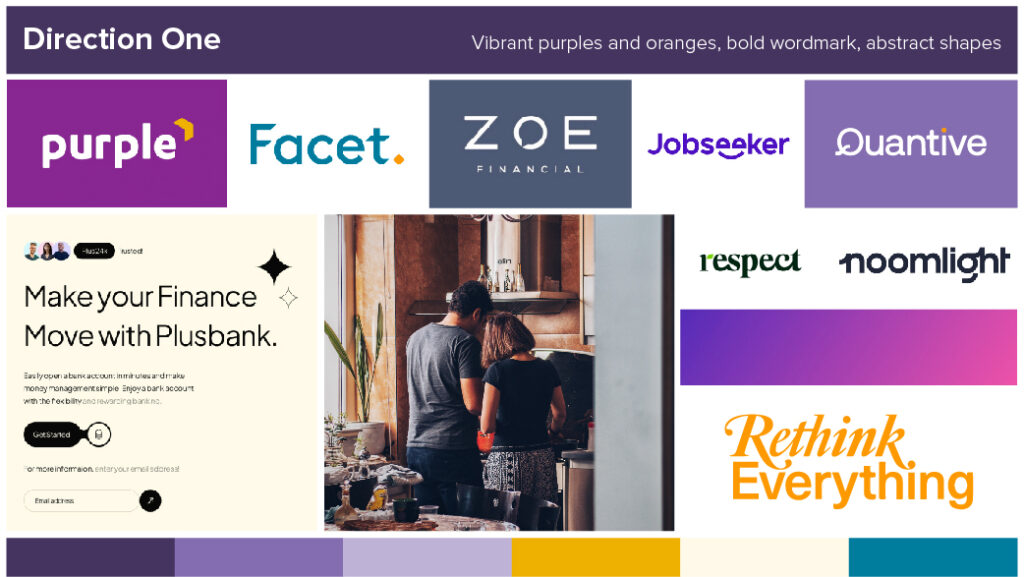
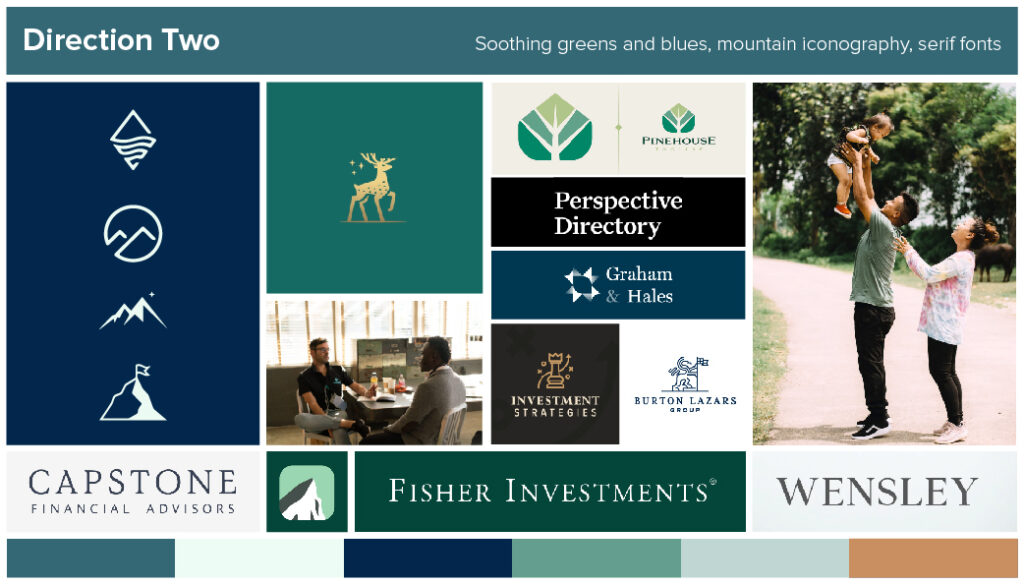
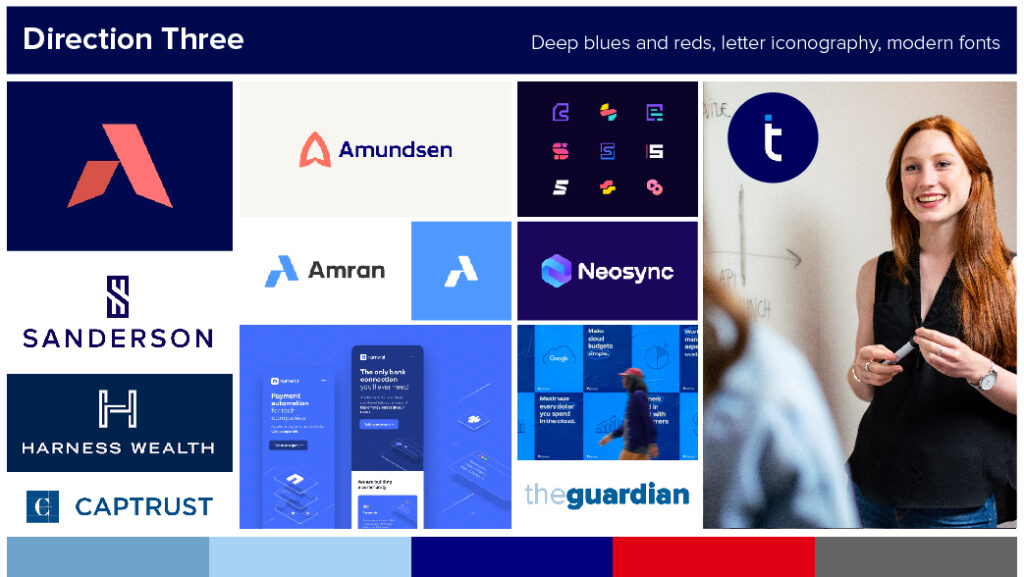
Here we can see a range from very modern and young to more traditional, and finally, to more contemporary and corporate. After discussing with the Tenzing team, they were drawn to direction three but with elements from the other two moodboards. A blue color palette with a splash of bold color, a clean sans serif font, and multiple options for logo marks, including a mountain and letter-based iconography.
Step Four: Logo Development
After moodboard approval, logo development truly begins. It’s time for the designer to start fully fleshing out the visual identity of the brand. At this point, we have identified a look and feel for the brand and the story we are trying to tell. We’ll then pursue several directions we want to explore for the logo surrounding different imagery and typography treatments.
Once we have a group of eight to fifteen logos that we are certain will serve the client well, we open it up to a cross-functional internal team. In our meeting, we review the first group of logos from the viewpoint of the brand’s clients, attributes, and industry. After this review, feedback is compiled, changes are made, and those fifteen concepts whittle down to three to five.
Typically at PHOS, a designer will spend anywhere between forty to sixty hours exploring different logo directions, iterating, and refining concepts.
When reviewing a logo design, it’s crucial that clients can envision how it will work in various situations and contexts. Each logo concept is displayed in different color variations and presented on a high fidelity mockup of signage, clothing, or other materials.
Step Five: Finalizing and Packaging
Similar to the moodboarding process, each concept is presented, but we then have the client completely nix one. The other concepts are then opened up for discussion with the goal of choosing one to finalize by the end of the meeting.
These are the four logos we showed to the Tenzing Financial Advisor’s team. Any one of these concepts would have served the Tenzing team well. With our guidance, the decision was up to them:
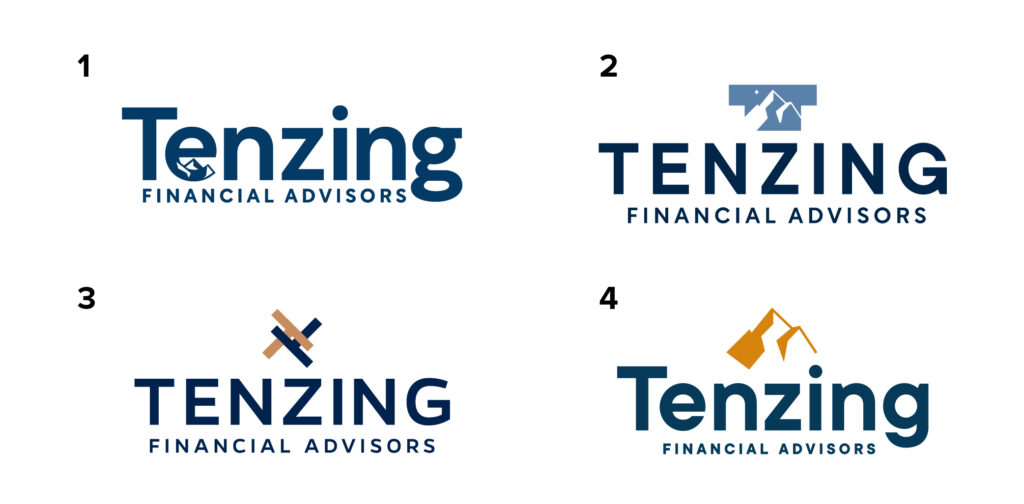
The Tenzing team immediately discounted option one after realizing that a stylized wordmark was not the direction they wanted to go. Option two was cut next as the icon was their least favorite. In the end, option three was chosen, but they expressed not loving the all caps font. With that in mind, we made edits bringing in the typography style from option four to round out their final logo:
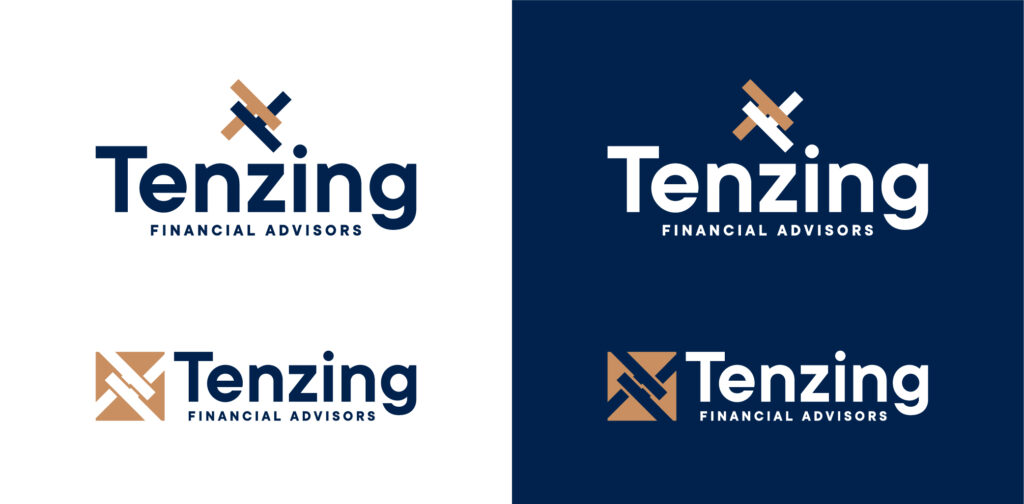
The logo’s icon is built out with intersecting letter T’s; it is also an abstract representation of hands pulling a climber up a mountain. There is boldness and modernity to the font that offsets the more corporate blue. Further contrasting the blue is a strong orange that provides energy to the upward motion of the icon. Coming back to Tenzing’s brand attributes, this logo communicates best-in-class but not formal, fun but not silly, and approachable but not standardized.
Once we receive final approval for the logo, a logo package is then created with the following assets:
- Logo Files: for print and digital in all useful file formats
- Social Media Package: profile pictures and cover photos for all social media platforms the organization is on
- Collateral: this can include flyers, business cards, etc.
- Brand Guidelines: a digital booklet containing key brand rules for typography, color palette, and logo usage.
There you have it, from a non-existent brand to a new logo with an established brand direction. There is no doubt that your logo is important, but it really is the cherry on top of the branding process. Any logo may look good, but for that logo to work as part of a brand system and to authentically represent what makes your organization and its team unique, you have to take the right foundational steps. Follow the process, and understand your story, and how you want to tell it—only then can you build a remarkable brand.
Amplify Your Brand with PHOS
Steve Forbes, editor in chief at Forbes Magazine, once said that “Your brand is the single most important investment you can make in your business.” If you’re ready to discover your authentic brand and shape how it is perceived in the wider world, then we hope that you’ll give us the chance to invest in that process with you.
PHOS has evolved our branding process over the last decade into an intentional experience that we are truly proud of. If you’re interested in partnering with us on your logo design project, connect with us online.







